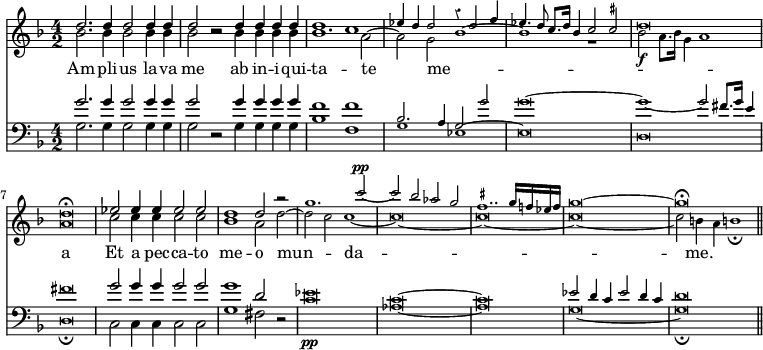
The second Verse is sung, in unisonous Plain Chaunt, to the Second Tone, transposed.

We first meet with the Abellimenti in the third Verse, which is sung in the form of a Concertino—that is to say, by a Choir of four choice Solo Voices. In the following example, the text of the Faux-bourdon is printed in large notes, and the two Abellimenti—one at the end of each clause—in small ones.[1]

In describing this beautiful passage, Mendelssohn says, 'The Abellimenti are certainly not of antient date; but they are composed with infinite talent, and taste, and their effect is admirable. This one, in particular,[2] is often repeated, and makes so deep an impression, that, when it begins, an evident excitement prevades all present.… The Soprano intones the high C, in a pure soft voice, allowing it to vibrate for a time, and slowly gliding down, while the Alto holds its C steadily; so that, at first, I was under the delusion that the high C was still held by the Soprano. The skill, too, with which the harmony is gradually developed, is truly marvellous.'
The unisonous melody of the fourth Verse serves only to bring this striking effect into still bolder relief.

The fifth Verse is sung like the first; the sixth, like the second; the seventh, like the third; and the eighth, like the fourth: and this order is continued—though with endless variations of Tempo, and expression—as far as the concluding Strophe, the latter half of which is adapted to a Double Chorus, written in nine parts, and sung very slowly, with a constant ritardando, 'the singers diminishing or rather extinguishing the harmony to a perfect point.'[3]
- ↑ The accidentals in brackets are undoubtedly due to the caprice of individual Singers.
- ↑ That is, the last shewn in our example.
- ↑ These words are Burney's. Adami's direction is, L'ultimo verso del Salmo termina a due Cori, e però sarà la Battuta, Adagio, per fuirlo Piano, smorzando poco a poco l'Armonia.

